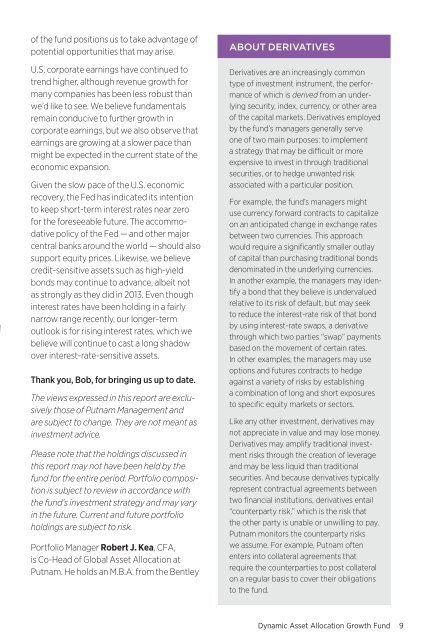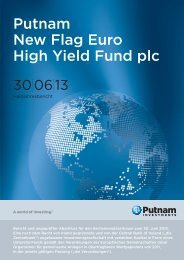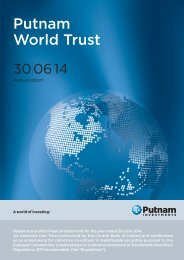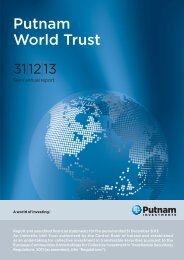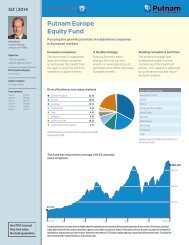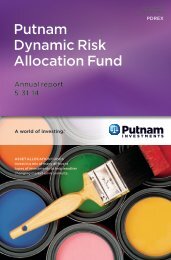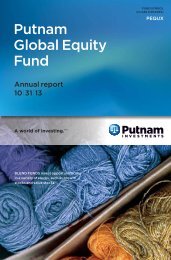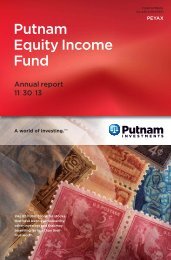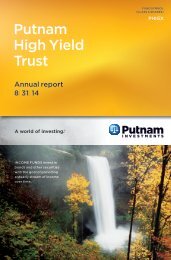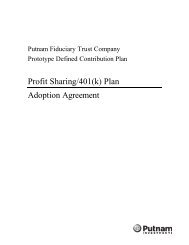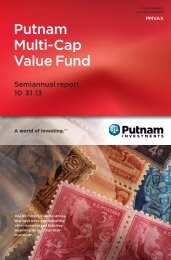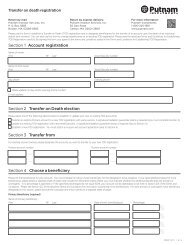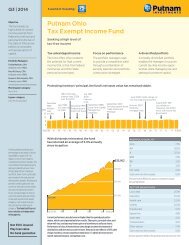March - Putnam Investments
March - Putnam Investments
March - Putnam Investments
- No tags were found...
Create successful ePaper yourself
Turn your PDF publications into a flip-book with our unique Google optimized e-Paper software.
of the fund positions us to take advantage ofpotential opportunities that may arise.U.S. corporate earnings have continued totrend higher, although revenue growth formany companies has been less robust thanwe’d like to see. We believe fundamentalsremain conducive to further growth incorporate earnings, but we also observe thatearnings are growing at a slower pace thanmight be expected in the current state of theeconomic expansion.Given the slow pace of the U.S. economicrecovery, the Fed has indicated its intentionto keep short-term interest rates near zerofor the foreseeable future. The accommodativepolicy of the Fed — and other majorcentral banks around the world — should alsosupport equity prices. Likewise, we believecredit-sensitive assets such as high-yieldbonds may continue to advance, albeit notas strongly as they did in 2013. Even thoughinterest rates have been holding in a fairlynarrow range recently, our longer-termoutlook is for rising interest rates, which webelieve will continue to cast a long shadowover interest-rate-sensitive assets.Thank you, Bob, for bringing us up to date.The views expressed in this report are exclusivelythose of <strong>Putnam</strong> Management andare subject to change. They are not meant asinvestment advice.Please note that the holdings discussed inthis report may not have been held by thefund for the entire period. Portfolio compositionis subject to review in accordance withthe fund’s investment strategy and may varyin the future. Current and future portfolioholdings are subject to risk.Portfolio Manager Robert J. Kea, CFA,is Co-Head of Global Asset Allocation at<strong>Putnam</strong>. He holds an M.B.A. from the BentleyABOUT DERIVATIVESDerivatives are an increasingly commontype of investment instrument, the performanceof which is derived from an underlyingsecurity, index, currency, or other areaof the capital markets. Derivatives employedby the fund’s managers generally serveone of two main purposes: to implementa strategy that may be difficult or moreexpensive to invest in through traditionalsecurities, or to hedge unwanted riskassociated with a particular position.For example, the fund’s managers mightuse currency forward contracts to capitalizeon an anticipated change in exchange ratesbetween two currencies. This approachwould require a significantly smaller outlayof capital than purchasing traditional bondsdenominated in the underlying currencies.In another example, the managers may identifya bond that they believe is undervaluedrelative to its risk of default, but may seekto reduce the interest-rate risk of that bondby using interest-rate swaps, a derivativethrough which two parties “swap” paymentsbased on the movement of certain rates.In other examples, the managers may useoptions and futures contracts to hedgeagainst a variety of risks by establishinga combination of long and short exposuresto specific equity markets or sectors.Like any other investment, derivatives maynot appreciate in value and may lose money.Derivatives may amplify traditional investmentrisks through the creation of leverageand may be less liquid than traditionalsecurities. And because derivatives typicallyrepresent contractual agreements betweentwo financial institutions, derivatives entail“counterparty risk,” which is the risk thatthe other party is unable or unwilling to pay.<strong>Putnam</strong> monitors the counterparty riskswe assume. For example, <strong>Putnam</strong> oftenenters into collateral agreements thatrequire the counterparties to post collateralon a regular basis to cover their obligationsto the fund.Dynamic Asset Allocation Growth Fund 9


